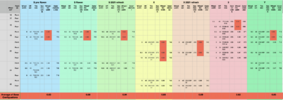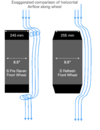As I changed tires on our Y, I was surprised to see that the rims were much, much wider than on our S (9.5"vs 8"), even though the tires are similar (245-255 wide, 703-713 mm dia.). Both cars have the base tires and wheels. The S wheel/tire width ratio is 0.83 vs 0.95 on the Y. Huge difference!
The question is: Why?
These things don't happen by accident. I ruled out looks because the base wheels are usually made to look as boring as possible to motivate you to opt for more expensive wheels.
The S wheels are marginally wide enough for its tires, whereas the Y wheels are almost too wide for its tires, based on what I can see in various online tire to rim width recommenders.
I got curious, looked up each model's wheel specification consolidated it in this table:

I highlighted in red the base set up on all models, which also happen to be the configurations with the most range in each case. Do you see the pattern?
If not, here it is: As you move up through the years and the model iterations, the wheel/tire width ratio increases in a linear fashion.
Considering how much range per kWh has increased over the years, it's unlikely only internal efficiency. If you look at drivetrain effeciency it hasn't increased as much as range/energy. Aerodynamics is a big part. Can aerodynamics have motivated the wheel/tire ratio change? This seems especially probable for the S, since it had almost the same body all along, while the wheel tire set up has changed substantially. How did the S go from its listed 0.24 C/D in 2012 to 0.208 in 2021? Some small details, but mostly wheels, I think. It is commonly accepted that wheels count for about 30% of the drag btw.
After looking at this this table I came up with this hypothesis:
Some of the original design constraints for the S might have been max frontal area and minimum acceptable tire section (245 mm). Consequently they selected as narrow a rim as possible, while still getting acceptable handling, to pull in the tire sidewalls.
Upon further research and testing they probably noticed that the overall drag could become even less with the smoother shoulder created by a wider rim, despite more frontal area. This is why we saw higher wheel/tire ratio on subsequent Teslas.

The question is: Why?
These things don't happen by accident. I ruled out looks because the base wheels are usually made to look as boring as possible to motivate you to opt for more expensive wheels.
The S wheels are marginally wide enough for its tires, whereas the Y wheels are almost too wide for its tires, based on what I can see in various online tire to rim width recommenders.
I got curious, looked up each model's wheel specification consolidated it in this table:
I highlighted in red the base set up on all models, which also happen to be the configurations with the most range in each case. Do you see the pattern?
If not, here it is: As you move up through the years and the model iterations, the wheel/tire width ratio increases in a linear fashion.
Considering how much range per kWh has increased over the years, it's unlikely only internal efficiency. If you look at drivetrain effeciency it hasn't increased as much as range/energy. Aerodynamics is a big part. Can aerodynamics have motivated the wheel/tire ratio change? This seems especially probable for the S, since it had almost the same body all along, while the wheel tire set up has changed substantially. How did the S go from its listed 0.24 C/D in 2012 to 0.208 in 2021? Some small details, but mostly wheels, I think. It is commonly accepted that wheels count for about 30% of the drag btw.
After looking at this this table I came up with this hypothesis:
Some of the original design constraints for the S might have been max frontal area and minimum acceptable tire section (245 mm). Consequently they selected as narrow a rim as possible, while still getting acceptable handling, to pull in the tire sidewalls.
Upon further research and testing they probably noticed that the overall drag could become even less with the smoother shoulder created by a wider rim, despite more frontal area. This is why we saw higher wheel/tire ratio on subsequent Teslas.
Attachments
Last edited:





